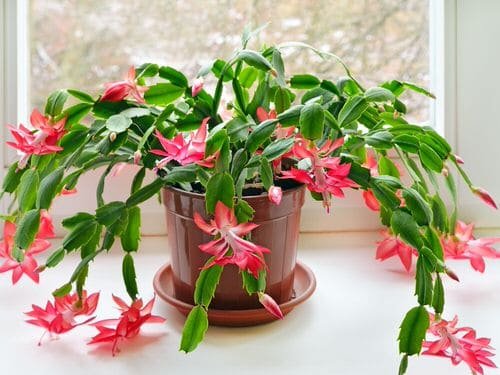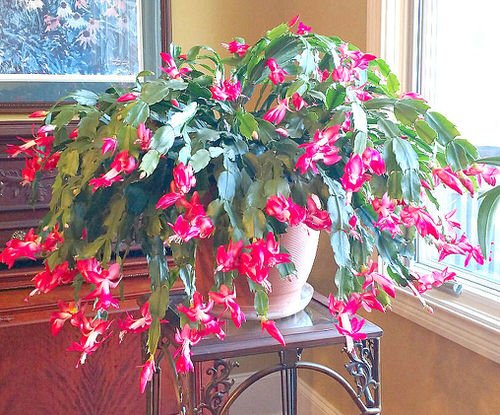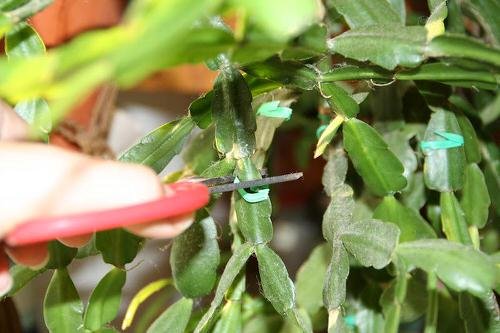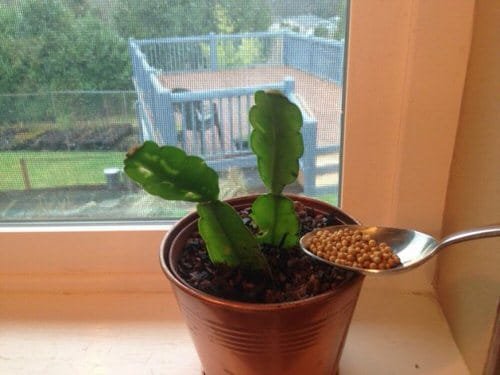Wondering if your Christmas Cactus will bloom this holiday season? Check out these simple tips on How to Make a Christmas Cactus Bloom at Christmas!

A blooming Christmas Cactus will have your heart with its colorful tubular flowers in pink and lilac shades. Although, this popular houseplant can be tricky to flower if not nurtured carefully. Read on to know the best tips on How to Make a Christmas Cactus Bloom at Christmas!
Check out our article on the Popular Holiday Cactus types here!
Most Common Mistakes that Stops Christmas Cactus to Bloom
- Overwatering during the blooming season
- Keeping the soil too dry once buds appear
- Over-fertilizing after visible flower buds
- Interrupted darkness
- Locating the plant in direct sunlight after bud formation.
- Placing the cactus at a windy location, which blows away the flower buds
- Pruning the plant during blooming season
- Frequent repotting of the succulent
How to Make a Christmas Cactus Bloom at Christmas?
1. Ideal Light & Temperature Conditions

Proper light and temperature is the most crucial part of making a Christmas cactus bloom. They bloom best when the days are short, and the temperature is moderately cool.
- Firstly, tuck your Christmas cactus indoors. Keep it at a temperature around 60 F (15-16 C) until the first flower buds appear.
- During this period, your succulent needs uninterrupted darkness of 14-16 hours (or at least 12 hours) and 8-9 hours of bright indirect sunlight (no harsh direct sunlight) for at least 4-6 weeks or until the buds appear.
- For the best result, don’t turn on even a light bulb where you’re keeping the plant for some days.
- If you can’t maintain a dark room–the best trick is to cover the plant with something like a cardboard box at a fixed time in the evening and uncover it in the morning.
- It’s ideal to begin this cycle from mid-September to get full blooms during Christmas. However, you can do this as late as early November. After this period of intense darkness, the plant will show its first flower buds after some time.
- The blooms will appear in 6-12 weeks after doing this.
Pro Tip: Do not let artificial lighting in your room disturb the dark environment of the cactus.
2. Minimal Watering

A blooming Cactus will adorn your tea table this Christmas if you swear by a few steps!
- Water your Christmas cactus sparingly until the appearance of the first flower buds.
- Allow excess water to drain out from the soil. Water-logged conditions will rot your succulent.
- Moisten only when the topsoil feels dry to the touch. This will allow the plant to enter dormancy, which will encourage it to bloom.
- After it has formed buds, start watering it regularly to promote more blooms.
- Once the flower buds appear, avoid inconsistent watering. One long dry spell and buds may fall.
- Make sure not to overwater it either, as it may cause bud drop.
3. Humidity

Christmas cactus is an epiphytic succulent and belongs to the rainforests of Brazil, which means it grows in shady and humid surroundings naturally. This is the reason why it enjoys some coolness and humidity around it. Ensure the right humid conditions to help your succulent bloom.
- Christmas cactus needs 50-60% humidity in the air to bloom. Use a humidifier to raise the moisture in the air.
- You can create a DIY humidity tray on dry days by filling a saucer with pebbles and halfway water. The water will then evaporate, making the atmosphere humid. Make sure to place the pot above the waterline in the saucer.
- You can also mist your cactus to supply more humidity, but this trick doesn’t work that well compared to the above two. Also, misting must not be done when the plant is in dormancy.
4. Do Not Move

Bud drop can be heart-breaking if you are not cautious while handling Christmas cactus.
- Moving your cactus from one location to another will cause a sudden change in light and temperature conditions, which will drop off the forming flower buds.
- New buds are too fragile.
- Please do not move the succulent or alter the growing conditions until it shows full prominent buds.
- Once the buds appear, you can start regular care of the plant. Move it to a little warmer and brighter spot and start consistent watering.
- But avoid sudden change than previous conditions. Don’t try to position it at a sunny spot, a location with cold drafts and extreme temperature change.
- Basically, don’t expose the plant to any stressful conditions once it forms the buds.
5. Pruning

Pruning the plant at the right time is the best trick to get more blooms at Christmas.
- Trim your cactus after a month or two of the blooming season. At this time, the plant enters the growing phase and grows new leaves.
- Pinch out 1-2 segments to give it a bushy look. It will then branch out with new leaves, which will further bloom.
- Pruning is best done in spring and can be done until late spring for best growth. But do NOT touch the plant in its dormancy or just before the blooming season.
Learn everything about Pruning a Christmas cactus in this article
6. Repotting

Christmas cactus loves to stay root-bound. Keep a few things in mind while re-potting.
- Repot it in every three years or when the growth seems to have stopped, and it’s looking too pot bound.
- The best time to repot a Christman cactus is during the summer months when it’s branching out new leaves. This helps the plant to adapt to the new conditions before the flowering process starts.
- Never transplant this succulent after the buds appear; it will result in bud drop.
Learn the detailed steps to prune a Christmas cactus here
7. Fertilizer

The right feeding schedule is crucial for the plant to bloom during Christmas.
- Feed your cactus with a balanced, water-soluble fertilizer like 20-20-20 or 20-10-20 in a weak dose (half or one-quarter of the recommended strength), once in 2-4 weeks during the growing period.
- Usually, from March to October (or up to November), this will strengthen the roots and overall growth of the plant.
- You can fertilize year-round in a frost-free climate (USDA Zones 10-11), whenever the plant needs.
- You can also apply a meager amount (1 teaspoon in a gallon of water) of Epsom salt dissolved in water sometimes as this plant wants extra magnesium.
- Never fertilize a Christmas cactus after visible budding and when it is flowering, as it will drop off the buds.
- Stop fertilizing the succulent once the plant stops growing, i.e., in the winter months. Feeding the plant while it’s not actively growing will result in salt buildup around the root, which will keep off blooming.



you missed out 1 point and that is of feeding the plant once a month august to point of budding
Happy read this have third c cactus now thanks ?
Apparently my Schlumbergera did not know the rules as it doesn’t follow all of them. I put it outside on the patio is late spring/early summer, water when dry to t he touch and use plant food sticks for flowering plants. I bring it in before the first frost, this season it was in October and it had begun to set buds. It hang in a ENE facing window in my living room, gets light from the ceiling light as well as from the street light and passing traffic. I carry it to the kitchen sink to water it, so I can give it a good soaking (when dry to the touch). I keep my heat set between 68 and 72, of course it is cooler in the window. I also mist the entire plant a couple of times a day. Mine is white and from the Turncata Group. It has had 2 flushes of bloom since it’s first few lowers in October. second flush was for Thanksgiving when it displayed 30+ blooms and buds as well as several tiny buds I didn’t add to the count. I believe it will have yet another flush of flowers for Christmas as well as sporadic blooms throughout the winter months – normal for this particular plant. I also have a smaller version of this plant grown from stems and pieces that were broken off of it when it fell from it’s shelf in 2014, it is now full of buds and just beginning to open a few.
These guide line are great to follow as most are not as forgiving as my plant is! I have another Schumbergeria, this from the Buckleyi Group and most likely S. russelliana. It was saved from my neighbor’s plant that was nearly lost to root rot in 2014. I got to keep the smallest, weakest pieces and while they have grown great, it shows no inclination of wanting to bloom! It gets the exact care as the others do. Perhaps when it is fully and completely recovered it will bloom.
Probably the one saved from your neighbor is actually a different type all together. There is a Susan Komen spring cactus that is particularly hard to get to rebloom. Like the same care as the traditional Christmas cactus but slightly less water and more direct light. Just a guess?!
My room don’t get Sun but I got my plants in doors the only time it’s Sun is at summertime but my plant don’t bloom .help
Florecent lights
I read an article where a lady inherited her plant from her deceased grandmother and it wasn’ t flowering and then she remembered that her grandmother used to give it A weekly feed of cold coffee and it flowered, worth a try.
It would be good to know what country/state is the the writer of this article in.
Mine never bloomed until my aunt told me it needs only natural light. Since I followed this advice my cactus has been full of blooms yearly! God’s beauty thrills my heart every year!
My plant bloomed this past December now it is getting ready to bloom again. I recently moved to a colder region since January, since that time I have kept it on the porch as before where now it gets sun from the West for about 4 hours daily and it’s about to bloom again. I’m not sure about the variety and its blooms be a gorgeous pink.
I guess mine don’t read the rules! I have several solid reds, a white, a pink, a peach, a salmon, and a baby one that is supposed to be gold. All are under LED plant lights for 8-10 hours a day and they do receive some natural light as well as from a lamp in my living room. I water lightly 2-3 times a month until they start setting buds. Then I fertilize with each watering maybe once a week. The reds, pink, and white ones are on their second bloom this year! They had never rebloomed until this past Christmas and then only sparingly. I added lights and blam, they’ve gone nuts! No idea if they’ll try to bloom for this holiday but I sure have pretty “Oktoberfest” cacti right now!🤣
I have a red Christmas cactus lt grew great had flowers at Christmas and after in Feb l have it in a window water it when dry mist once a week use miracle grow sticks l have 3 in the pot placed in a triangle once every 4 months l repotted it a couple months ago and broke 1/2 of it off it has started growing back right now it’s leaves are making leaves seems to be happy it’s in a bigger pot. I live on Florida so l don’t put it outside at all the heat here will surely kill it l keep it in a window where it gets light from outside and a little sun and l don’t move it after it blooms it’s in my office it’s thriving there.